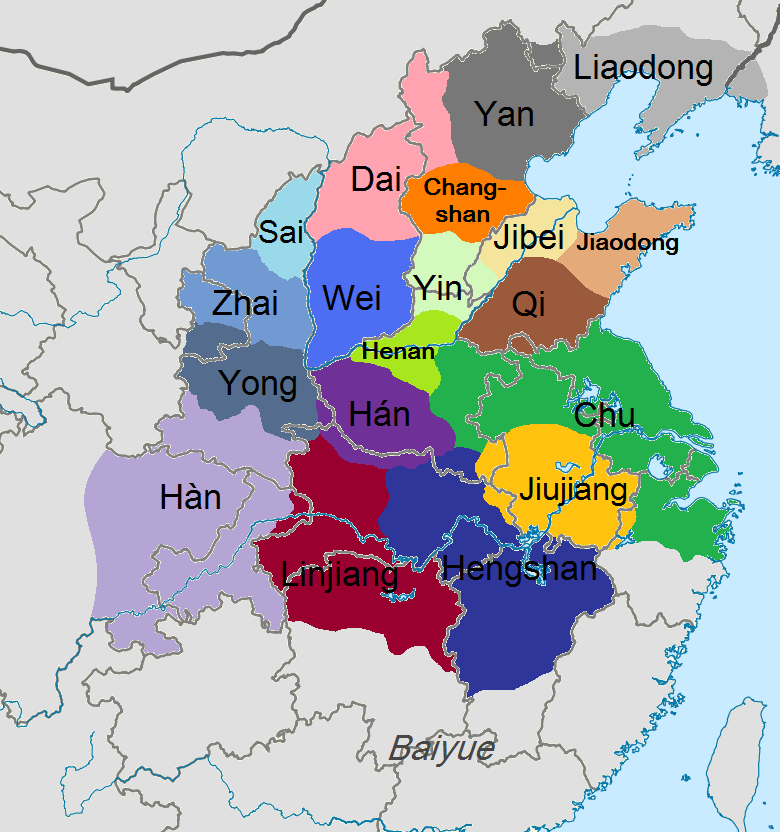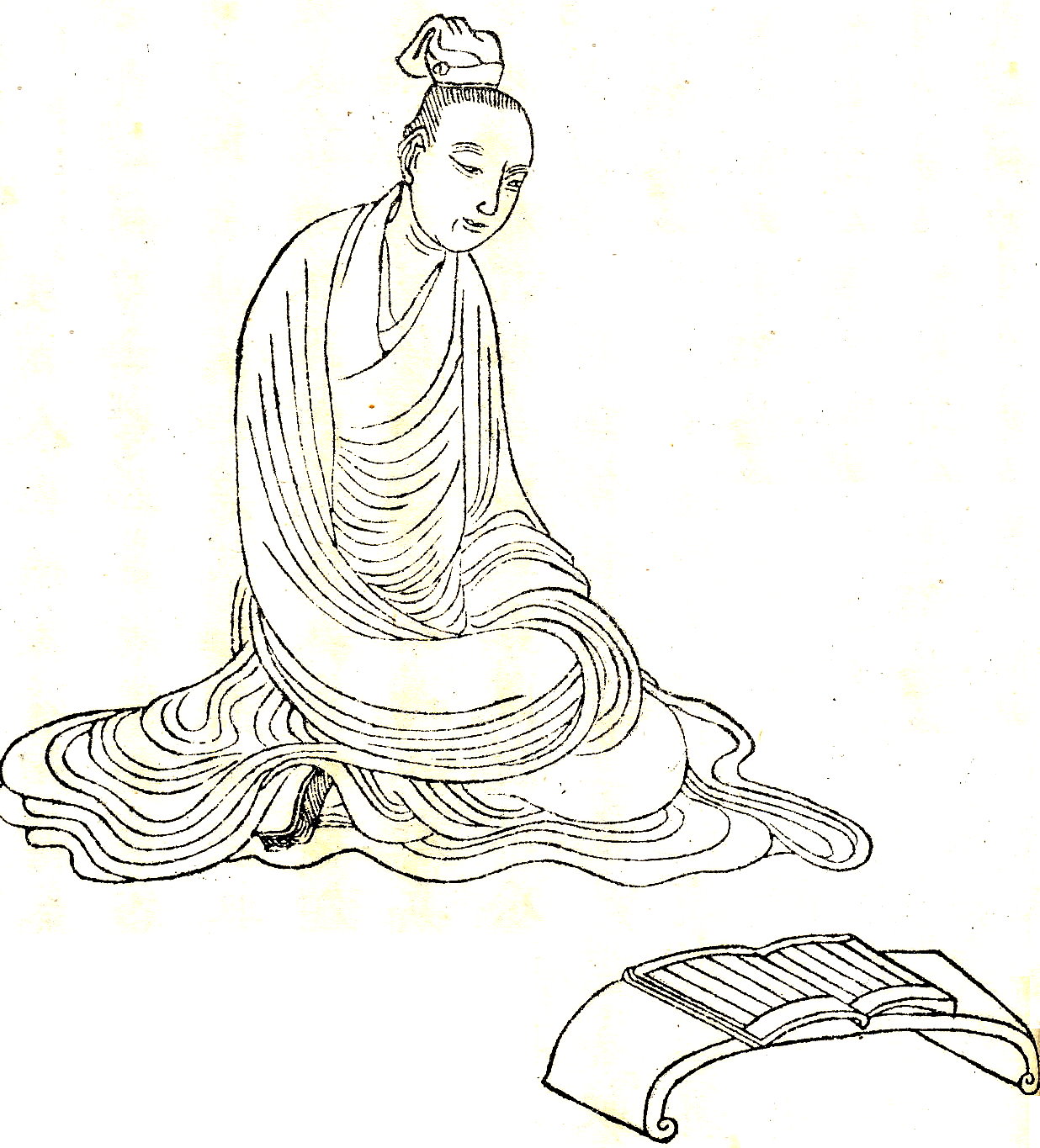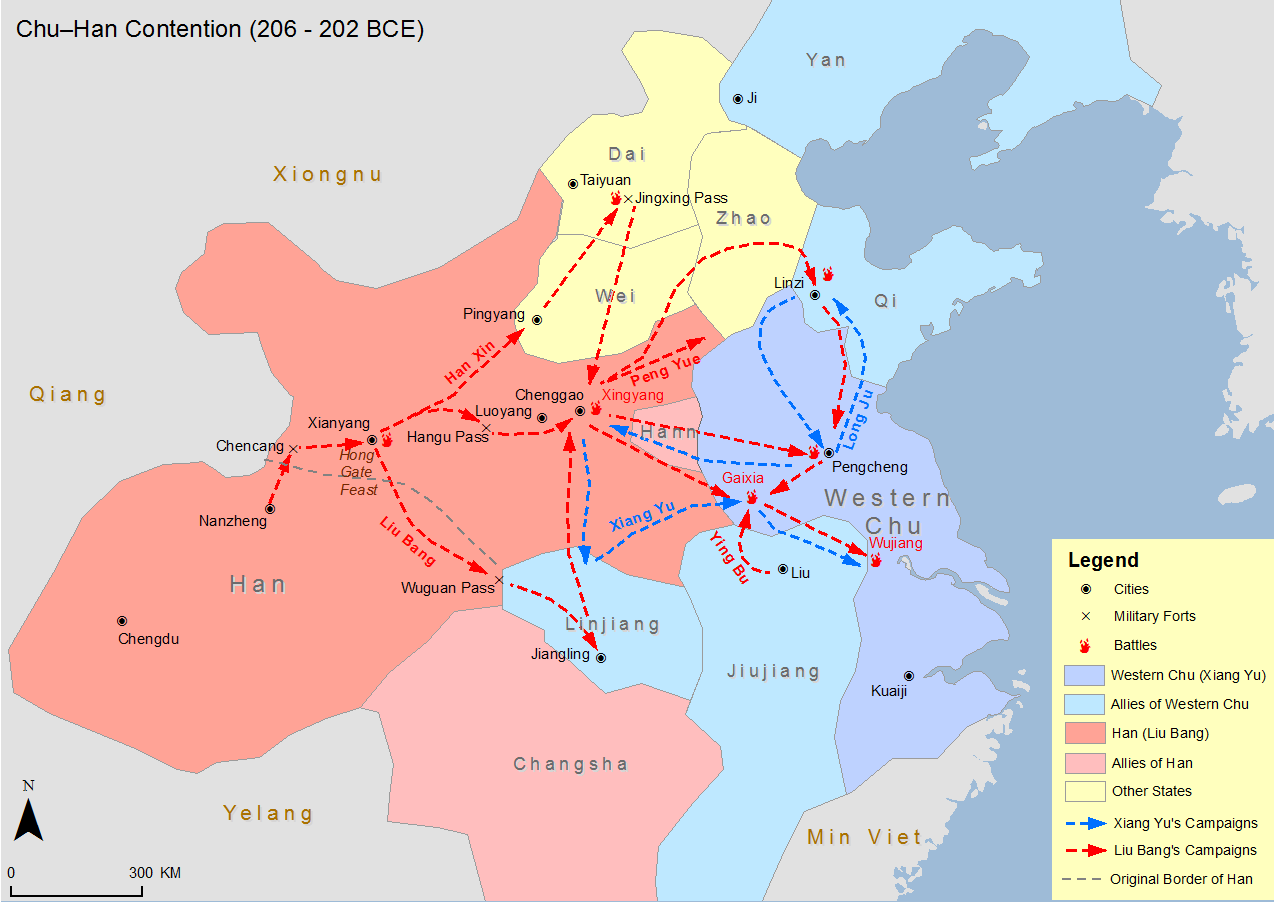|
Three Qins
The Three Qins () refer to three of the Eighteen Kingdoms, the short-lived power-sharing arrangement formed in 206 BC after the collapse of the Qin Dynasty. The three kingdoms were located in Guanzhong Plain (in present-day central Shaanxi), the heartland of the Qin Empire. Background In late 208 BC the rebel king of Chu, King Huai II, promised that whoever invaded Guanzhong first would rule the region. In late 207 the Chu rebel Liu Bang became the first anti-Qin rebel to enter the Guanzhong region, capturing the Qin capital Xianyang and receiving the surrender of Ziying, the last king of Qin. He also won the support of the people of Guanzhong by abolishing the harsh Qin laws and by forbidding his troops from killing and robbing the locals. For these reasons, Liu Bang had a strong claim to Guanzhong, which was grain-rich, populous, easily defensible and ideal for expansion into China's Central Plain. However, the Chu rebel Xiang Yu, the most powerful rebel warlord at the ti ... [...More Info...] [...Related Items...] OR: [Wikipedia] [Google] [Baidu] |
Eighteen Kingdoms
The historiographical term "Eighteen Kingdoms" ( zh, t=十八國), also translated to as "Eighteen States", refers to the eighteen ''fengjian'' states in China created by military leader Xiang Yu in 206 BCE, after the collapse of the Qin dynasty.林达礼,中华五千年大事记, 台南大孚书局, 1982, p. 56 The establishment and abolishment of the Eighteen Kingdoms marked the beginning and end of a turbulent interregnum known as the Chu-Han Contention. The details of the feudal division are as follows: The Eighteen Kingdoms were short-lived: almost immediately rebellion broke out in Qi, after which Tian Rong conquered Jiaodong and Jibei, reuniting the old Qi state. Meanwhile, Xiang Yu had Emperor Yi of Chu and King Han Cheng of Hán killed. Thereafter, Liu Bang of Hàn conquered the lands of the Three Qins, thereby formally starting the Chu–Han Contention. Following many battles and changing alliances, Hàn defeated Chu and subdued all other kingdoms, where Liu Bang a ... [...More Info...] [...Related Items...] OR: [Wikipedia] [Google] [Baidu] |
Shaanxi
Shaanxi (alternatively Shensi, see #Name, § Name) is a landlocked Provinces of China, province of China. Officially part of Northwest China, it borders the province-level divisions of Shanxi (NE, E), Henan (E), Hubei (SE), Chongqing (S), Sichuan (SW), Gansu (W), Ningxia (NW) and Inner Mongolia (N). Shaanxi covers an area of over with about 37 million people, the 16th highest in China. Xi'an – which includes the sites of the former Capitals of China, Chinese capitals Fenghao and Chang'an – is the Xi'an, provincial capital as well as the largest city in Northwest China and also one of the oldest cities in China and the oldest of the Historical capitals of China, Four Great Ancient Capitals, being the capital for the Western Zhou, Western Han, Sima Jin, Jin, Sui dynasty, Sui and Tang dynasty, Tang List of Chinese dynasties, dynasties. Xianyang, which served as the Qin dynasty capital, is just north across Wei River. The other Prefectures of China, prefecture-level pr ... [...More Info...] [...Related Items...] OR: [Wikipedia] [Google] [Baidu] |
Xiang Liang
Xiang Liang (died 208 BC) was a military leader who led a rebellion against the Qin dynasty. Early life Xiang Liang was from Xiaxiang (下相; present-day Suqian, Jiangsu) and was a descendant of a family who served the Chu state in the Warring States period. Xiang Liang's father, , was a famous general who led the Chu army to resist the invading Qin forces led by Wang Jian, and was killed in action in 223 BC when Qin annexed Chu. After the fall of Chu, Xiang Liang and his brothers became commoners and lived under Qin rule for years. When Xiang Liang's elder brother Xiang Chao () died, Xiang Liang took Xiang Chao's son, Xiang Yu, under his care. Xiang Liang doted on Xiang Yu and had his nephew instructed in scholarly arts and swordsmanship, but Xiang Yu did not master what he was taught and Xiang Liang was very displeased with him.Sima Qian. ''Records of the Grand Historian'', Volume 7, Biography of Xiang Yu. When Xiang Yu expressed interest in military strategy, Xiang Liang t ... [...More Info...] [...Related Items...] OR: [Wikipedia] [Google] [Baidu] |
Chen Sheng
Chen Sheng (died January 208 BC), also known as Chen She ("She" being his courtesy name), posthumously known as Prince Yin, was the leader of the Dazexiang Uprising, the first rebellion against the Qin Dynasty. It occurred during the reign of the Second Qin Emperor. Life Chen Sheng was born in Yangcheng (陽城; in present-day Fangcheng County, Henan). In August or September 209 BC, he was a military captain along with Wu Guang when the two of them were ordered to lead 900 soldiers to Yuyang (漁陽; southwest of present-day Miyun County, Beijing) to help defend the northern border against Xiongnu. Due to storms, it became clear that they could not get to Yuyang by the deadline, and according to law, if soldiers could not get to their posts on time, they would be executed. Chen Sheng and Wu Guang, believing that they were doomed, led their soldiers to start a rebellion. They announced that Fusu, the crown prince of Qin, who had wrongly been forced to commit suicide, and Xian ... [...More Info...] [...Related Items...] OR: [Wikipedia] [Google] [Baidu] |
Wu Guang
Wu Guang (, died December 209 BC or January 208 BC) was a leader of the first rebellion against the Qin Dynasty during the reign of the Second Qin Emperor. Life Wu Guang was born in Yangxia (陽夏; present-day Taikang County, Zhoukou, Henan), and his courtesy name was Shu. In August or September 209 BC,Volume 48 of ''Records of the Grand Historian'' dated the incident to the 7th month of the 1st year of the reign of Qin Er Shi. This corresponds to 9 Aug to 7 Sep 209 BC in the proleptic Julian calendar. (二世元年七月,发闾左适戍渔阳,九百人屯大泽乡。...) ''Shiji'', vol.48 he was a military captain along with Chen Sheng when the two of them were ordered to lead 900 soldiers to Yuyang (漁陽; southwest of present-day Miyun County, Beijing) to help defend the northern border against Xiongnu. Due to storms, it became clear that they could not get to Yuyang by the deadline, and according to law, if soldiers could not get to their posts on time, they would b ... [...More Info...] [...Related Items...] OR: [Wikipedia] [Google] [Baidu] |
Zhang Liang (Western Han)
:''Note: In this article, to distinguish between the Han state of the Warring States period and the Han dynasty, the former is referred to as "Hán" while "Han" is reserved for the latter.'' Zhang Liang ( 251 BC – 186 BC), courtesy name Zifang, was a Chinese military strategist and politician who lived in the early Western Han dynasty. He is also known as one of the "Three Heroes of the early Han dynasty" (), along with Han Xin () and Xiao He. Zhang Liang contributed greatly to the establishment of the Han dynasty. After his death, he was honoured with the posthumous title "Marquis Wencheng" by Emperor Qianshao. Zhang Liang is depicted in the Wu Shuang Pu (無雙譜, Table of Peerless Heroes) by Jin Guliang. Early life Zhang Liang was born in Xinzheng (新鄭; present-day Zhengzhou, Henan), the capital of the Hán state(), while his ancestral home was in Chengfu (城父; present-day Chengfu Town, Bozhou, Anhui). He descended from an aristocrat family in Hán. His grandfathe ... [...More Info...] [...Related Items...] OR: [Wikipedia] [Google] [Baidu] |
Han River (Hubei And Shaanxi)
The Han River, also known by its Chinese names Hanshui and Han Jiang, is a left tributary of the Yangtze in central China. It has a length of and is the longest tributary of the Yangtze system. The river gave its name to the Han dynasty and, through it, to the Han Chinese, the dominant ethnicity in China and the most populous ethnic group in the world. It is also the namesake of the city of Hanzhong on its upper course. Geography The headwaters of the Han flow from Mount Bozhong in southwestern Shaanxi. The stream then travels east across the southern part of that province. Its highland valley—known as the Qinba Laolin—divides and is protected by the Qinling or Qin Mountains to its north and the Dabashan or Daba Mountains to its south. The main cities are Hanzhong in the west and Ankang in the east. It then enters Hubei. It crosses most of Hubei from the northwest to the southeast, flowing into the Yangtze at the provincial capital Wuhan, a city of several million inhabi ... [...More Info...] [...Related Items...] OR: [Wikipedia] [Google] [Baidu] |
Qinling
The Qinling () or Qin Mountains, formerly known as the Nanshan ("Southern Mountains"), are a major east–west mountain range in southern Shaanxi Province, China. The mountains mark the divide between the drainage basins of the Yangtze and Yellow River systems, providing a natural boundary between North and South China and support a huge variety of plant and wildlife, some of which is found nowhere else on earth. To the north is the densely populated Wei River valley, an ancient center of Chinese civilization. To the south is the Han River valley. To the west is the line of mountains along the northern edge of the Tibetan Plateau. To the east are the lower Funiu and Dabie Shan which rise out of the coastal plain. The northern side of the range is prone to hot weather, however the physical barrier of the mountains mean that the land to the North has a semi-arid climate, with the lack of rich, fertile landscape that can not support a wealth of wildlife. The mountains also acted a ... [...More Info...] [...Related Items...] OR: [Wikipedia] [Google] [Baidu] |
Sichuan
Sichuan (; zh, c=, labels=no, ; zh, p=Sìchuān; alternatively romanized as Szechuan or Szechwan; formerly also referred to as "West China" or "Western China" by Protestant missions) is a province in Southwest China occupying most of the Sichuan Basin and the easternmost part of the Tibetan Plateau between the Jinsha River on the west, the Daba Mountains in the north and the Yungui Plateau to the south. Sichuan's capital city is Chengdu. The population of Sichuan stands at 83 million. Sichuan neighbors Qinghai to the northwest, Gansu to the north, Shaanxi to the northeast, Chongqing to the east, Guizhou to the southeast, Yunnan to the south, and the Tibet Autonomous Region to the west. In antiquity, Sichuan was the home of the ancient states of Ba and Shu. Their conquest by Qin strengthened it and paved the way for Qin Shi Huang's unification of China under the Qin dynasty. During the Three Kingdoms era, Liu Bei's state of Shu was based in Sichuan. The ... [...More Info...] [...Related Items...] OR: [Wikipedia] [Google] [Baidu] |
Xiang Yu
Xiang Yu (, –202 BC), born Xiang Ji (), was the Hegemon-King (Chinese: 霸王, ''Bà Wáng'') of Western Chu during the Chu–Han Contention period (206–202 BC) of China. A noble of the Chu state, Xiang Yu rebelled against the Qin dynasty and became a prominent warlord. He was granted the title of "Duke of Lu" () by King Huai II of the restoring Chu state in 208 BC. The following year, he led the Chu forces to victory at the Battle of Julu against the Qin armies led by Zhang Han. After the fall of Qin, Xiang Yu was enthroned as the "Hegemon-King of Western Chu" () and ruled a vast area covering modern-day central and eastern China, with Pengcheng as his capital. He engaged Liu Bang, the founding emperor of the Han dynasty, in a long struggle for power, known as the Chu–Han Contention, which concluded with his eventual defeat at the Battle of Gaixia and his suicide. Xiang Yu is depicted in the Wu Shuang Pu (, Table of Peerless Heroes) by Jin Guliang. Names and titles ... [...More Info...] [...Related Items...] OR: [Wikipedia] [Google] [Baidu] |
Zhongyuan
Zhongyuan (), the Central Plain(s), also known as Zhongtu (, lit. 'central land') and Zhongzhou (, lit. 'central region'), commonly refers to the part of the North China Plain surrounding the lower and middle reaches of the Yellow River, centered on the region between Luoyang and Kaifeng. It has been perceived as the birthplace of the Yellow River civilization, Chinese civilization. Historically, the Huaxia people viewed Zhongyuan as 'the Sinocentrism, center of the world'. Human activities in the Zhongyuan region can be traced back to the Paleolithic, Palaeolithic period. In prehistoric times, Huaxia, a confederation of tribes that later developed into the Han Chinese, Han ethnicity, lived along the middle and lower reaches of the Yellow River. The term 'Zhongguo' (Central State) was used to distinguish themselves from the Four Barbarians, Siyi tribes that were perceived as 'barbaric'. For a large part of History of China, Chinese history, Zhongyuan had been the political, econo ... [...More Info...] [...Related Items...] OR: [Wikipedia] [Google] [Baidu] |
Ziying
Ziying, King of Qin (, died January 206 BC) was the third and last ruler of the Qin dynasty. He ruled over a fragmented Qin Empire for 46 days, from mid-October to early December 207 BC. He is referred to in some sources with the posthumous name Emperor Shang of Qin (秦殤帝) although Qin abolished the practice of posthumous names. (In Chinese tradition, even someone who never held a ruling title while he was alive might be given the posthumous title "emperor" after his death.) Identity There is no firm consensus as to what Ziying's relationship to the Qin royal family really was. He is mentioned in historical records as either: #A son of Qin Er Shi's elder brother (who, according to Yan Shigu's commentaries, was Fusu); #An elder brother of Qin Er Shi; #A younger brother of Qin Shi Huang; or #A son of a younger brother of Qin Shi Huang. While Sima Qian's ''Records of the Grand Historian'' does not specify Ziying's age, it implies that he had at l ... [...More Info...] [...Related Items...] OR: [Wikipedia] [Google] [Baidu] |






